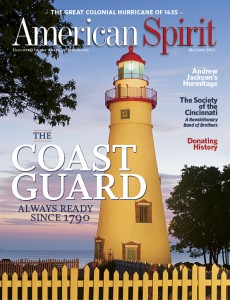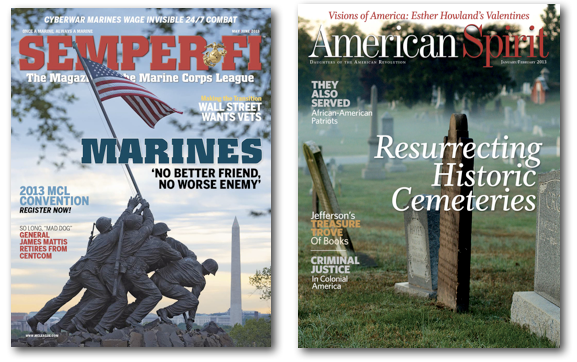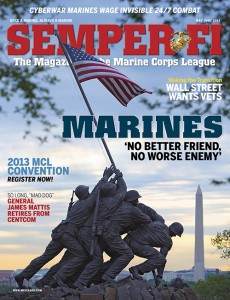


 In our May/June issue of American Spirit, the national magazine of the Daughters of the American Revolution (DAR)*, we remember an often-unsung branch of our Armed Forces: The United States Coast Guard. In our cover feature we detail the wide-ranging history of Coast Guard, which was originally created in 1790 to raise revenues and pull the nation out of debt. It has evolved into a guardian of our shores, a protector of our borders and an “Always Ready” life-saving service. As president George H.W. Bush said, “No branch of service has been in the business of saving lives longer than the Coast Guard. … No other branch does more to protect our environment. Few do as much to defend our homeland against the shadowy threats of illegal drugs and, now, terrorism. … This remarkable institution … is so clearly indispensable to America’s future.”
In our May/June issue of American Spirit, the national magazine of the Daughters of the American Revolution (DAR)*, we remember an often-unsung branch of our Armed Forces: The United States Coast Guard. In our cover feature we detail the wide-ranging history of Coast Guard, which was originally created in 1790 to raise revenues and pull the nation out of debt. It has evolved into a guardian of our shores, a protector of our borders and an “Always Ready” life-saving service. As president George H.W. Bush said, “No branch of service has been in the business of saving lives longer than the Coast Guard. … No other branch does more to protect our environment. Few do as much to defend our homeland against the shadowy threats of illegal drugs and, now, terrorism. … This remarkable institution … is so clearly indispensable to America’s future.”
Even with today’s high-tech weather radars and forecasting tools, extreme weather can uproot thousands of people, destroy homes and buildings and wreak havoc, as proven by the recent devastating tornadoes in Oklahoma and Hurricane Sandy on the East Coast. But what if such a storm came with absolutely no warning? That’s what happened in 1635,when a massive hurricane hit the coast of New England with winds estimated at 130 miles an hour, making it possibly the strongest hurricane ever to hit the region. Our feature shows how early Americans dealt with such severe weather events — and tried to make sense of the natural world.



Credit: ThinkStock
The current Hammock Idea Email points out the folly of investing in tactics advocated by those who promise they can magically improve the way Google ranks a company’s website. “You’ll never out-smart Google, so stop trying,” we advise.
Overtime, the only way to influence Google’s ranking is to, first and foremost, have a great product or service. Then follow Google’s guidelines and recommendations rigorously. This means, create a website filled with the most helpful, insightful information your customers look for related to the market niche your company serves.
With the release of the fourth version of Google’s war on link spam, an upgrade to the company’s algorithm they are calling Penguin 2.0, the message is clear: Try to outsmart Google and you’ll likely be penalized in the future.
There are dozens, make that hundreds, of things you can do to improve your site’s findability. Here are just five things you can do to make your site Pengiun 2.0-friendly:

Bonus Link: On his blog, Rex Hammock shares his favorite route to our new offices in Downtown Nashville.
 Recently, Chris Brogan invited Hammock CEO Rex Hammock onto his very popular podcast where they talked about how companies, associations and other organizations are using media and content to connect directly with their customers.
Recently, Chris Brogan invited Hammock CEO Rex Hammock onto his very popular podcast where they talked about how companies, associations and other organizations are using media and content to connect directly with their customers.
Last year, Forbes ranked Chris #1 on its list of top social media influencers. His books have appeared on the New York Times’ business bestsellers list and he’s in demand as a speaker, presenter and consultant.
Chris and Rex discuss a wide range of topics related to how customer media is helping businesses address bottom line challenges and opportunities. It lasts approximately 25 minutes and is an enjoyable listen for marketing geeks of all ages.


A successful customer media strategy hinges on what advertisers have long called “frequency” — the number of times a customer must be exposed to a message for it to be effective.
“One-and-done” customer media will disappoint your customers, as sure as “one-and-done” disappoints fans who see their team lose in the first round of the playoffs.
Recurring media is king. So recurring (and subscribable) media like magazines, newsletters, frequent blog posts and podcasts have been the early and effective tools of digital content marketers.
 Our current Idea Email is focused on the customer relationship-building opportunities of using a subscription model for the distribution of ebooks.
Our current Idea Email is focused on the customer relationship-building opportunities of using a subscription model for the distribution of ebooks.
Here are 5 tips we believe will help such a series of ebooks to become popular with your audience.
Keep it Short
By short, we mean 5,000-10,000 words. This is the length of a long magazine article. A business-to-business marketer may offer longer books, if your audience seeks content of a technical or academic nature. And a how-to or recipe series may be comprised of ebooks with less words. However, the success that Amazon.com has seen with Kindle Singles provides the proof-of-concept that short books are popular among people with demands on their time, but who desire more understanding than a blog post (like this) can provide.
 With the ongoing budget problems in Washington, and with America’s presence in Afghanistan winding down, many Marines and other service members will be returning to civilian life and looking for work in the near future. They may be surprised to learn that the values instilled in them during their service are highly desired by the financial services industry.
With the ongoing budget problems in Washington, and with America’s presence in Afghanistan winding down, many Marines and other service members will be returning to civilian life and looking for work in the near future. They may be surprised to learn that the values instilled in them during their service are highly desired by the financial services industry.
In “Psst! Hey Marine! Wall Street Wants … You!” in the July August issue of Semper Fi, the Magazine of the Marine Corps League, several Marine veterans tell how the discipline, commitment, resilience and dedication they learned in the Corps have helped them succeed in a tough, but rewarding business.
We also profile another Marine leaving active duty—General James N. “Mad Dog” Mattis. Outspoken, sometimes controversial but beloved by his Marines (and feared by his enemies), General Mattis had headed U.S. Central Command prior to retirement. He famously told his troops on the eve of Operation Iraqi Freedom to “Demonstrate to the world there is ‘No Better Friend, No Worse Enemy, than a U.S. Marine.'”
 David Ogilvy, the real-life Don Draper of Madison Avenue in the 1960s, is perhaps the most quoted, and misquoted, person in the history of marketing. One of his most popular quotes was about headlines: “On the average, five times as many people read the headline (of a print ad) as read the body copy. When you have written your headline, you have spent eighty cents out of your dollar.”
David Ogilvy, the real-life Don Draper of Madison Avenue in the 1960s, is perhaps the most quoted, and misquoted, person in the history of marketing. One of his most popular quotes was about headlines: “On the average, five times as many people read the headline (of a print ad) as read the body copy. When you have written your headline, you have spent eighty cents out of your dollar.”
That quotation is sometimes used by digital marketers as guidance for how to reach today’s short-attention-span customer. Say everything you need to say in the subject line, they advise. “If you can’t say something in 140 characters, then don’t say it,” we’re told.
Unfortunately, in the cited quotation, Ogilivy didn’t mean you have to say everything you need to say in a headline.
How do we know he didn’t mean that? Because the quote is buried deep inside an advertisement containing 1,909 words of copy. You read that correctly: 1,909 words!
Moreover, Ogilvy includes the following advice a few paragraphs later: ”People read long copy…. readership falls off rapidly up to 50 words, but drops very little between 50 and 500 words: The more you tell, the more you sell.”
For Ogilvy, advertising wasn’t merely about getting people to read your headline. It wasn’t even about getting people to read body copy. It was about one thing: selling.
Use short copy to sell. Use long copy to sell. Just make sure your advertising sells. Everything one does as a marketer is in service to the sell.
How to create customer media that sells